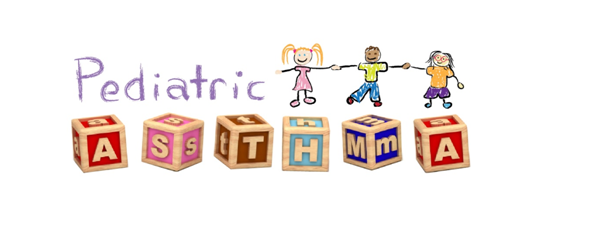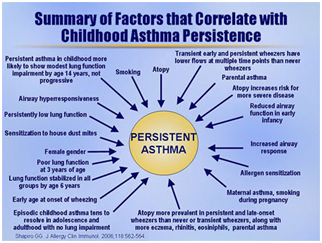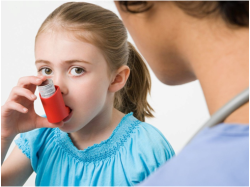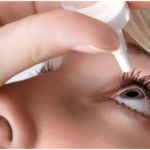Childhood Asthma

Causes
Asthma is caused by swelling in the airways. During an asthma attack, the muscles surrounding the airways tighten. The lining of the air passages swells. Less air is able to pass through as a result.
Asthma is often seen in children. It is a leading cause of missed school days and hospital visits for children. An allergic reaction is a key part of asthma in children. Asthma and allergies often occur together.
Some things that can bring on asthma symptoms (triggers) include

1
Animals (hair or dander)
2
Dust, mould, and pollen
3
Aspirin and other medicines
4
Cold air, such as changes in weather (most often cold weather)
5
Chemicals in the air or in food
6
Tobacco smoke
7
Exercise
8
Strong emotions
9
Viral infections, such as the common cold
Breathing problems are common.
They can include:
1
Shortness of breath
2
Feeling out of breath
3
Gasping for air
4
Trouble breathing out (exhaling)
5
Breathing faster than normal
Other symptoms of asthma in children include:
1
Coughing that sometimes wakes the child up at night (it may be the only symptom)
2
Dark bags under the eyes
3
Feeling tired
4
Irritability
5
Tightness in the chest
6
A whistling sound made when breathing (wheezing). You may notice it more when the child breathes out.
Your child’s asthma symptoms may vary. Symptoms may appear often or else develop only when triggers are present. Some children are more likely to have asthma symptoms at night.
Exams and Tests
Your doctor will to listen to the child’s lungs. Doctor may be able to hear asthma sounds. However, lung sounds are often normal when the child is not having an asthma episode. Doctor will have the child breathe into a device called a peak flow meter. Peak flow meters can tell how well the child can blow air out of the lungs. If the airways are narrow due to asthma, peak flow values drop.You and your child will learn to measure peak flow at home.
Tests may include:
1
Allergy testing
2
Chest x-ray
3
Eosinophil count (a type of white blood cell)
4
Eosinophil count (a type of white blood cell)
Treatment
Your doctor will to listen to the child’s lungs. Doctor may be able to hear asthma sounds. However, lung sounds are often normal when the child is not having an asthma episode. Doctor will have the child breathe into a device called a peak flow meter. Peak flow meters can tell how well the child can blow air out of the lungs. If the airways are narrow due to asthma, peak flow values drop.You and your child will learn to measure peak flow at home.
This plan will tell you how to:
1
Avoid asthma triggers
2
Monitor symptoms
1
Measure peak flow
2
Take medicines
The plan should also tell you when to call the nurse or doctor. It’s important to know what questions to ask your child’s doctor. Children with asthma need a lot of support at school.
Give the school staff your asthma action plan so they know how to take care of your child’s asthma. Find out how to let your child take medicine during school hours. (You may need to sign a consent form.)
Having asthma does not mean your child cannot exercise. Coaches, gym teachers, and your child should know what to do if your child has asthma symptoms caused by exercise.
Asthma medicines

Child_Asthma_Medicine There are two basic kinds of medicine used to treat asthma.
Long-term control drugs are taken every day to prevent asthma symptoms. Your child should take these medicines even if no symptoms are present. Some children may need more than one long-term control medicine.
Types of long-term control medicines include:
Quick relief or rescue asthma drugs work fast to control asthma symptoms.
Children take them when they are coughing, wheezing, having trouble breathing, or having an asthma attack.
Some of your child’s asthma medicines can be taken using an inhaler.
Children who use an inhaler should use a “spacer” device. This helps them to get the medicine into the lungs properly.
If your child uses the inhaler wrong way, less medicine gets into the lungs. Have your health care provider show your child how to correctly use an inhaler.
Younger children can use a nebulizer instead of an inhaler to take their medicine. A nebulizer turns asthma medicine into a mist.
Getting rid of triggers
It is important to know what things make your child’s asthma worse. These are called asthma “triggers.” Avoiding them is the first step toward helping your child feeling better.
It is important to know what things make your child’s asthma worse. These are called asthma “triggers.” Avoiding them is the first step toward helping your child feeling better.
No one should smoke in a house or around a child with asthma.
- Getting rid of tobacco smoke in the home is the single most important thing a family can do to help a child with asthma.
- Smoking outside the house is not enough. Family members and visitors who smoke carry the smoke inside on their clothes and hair. This can trigger asthma symptoms.
- Do not use indoor fireplaces.
Keep the house clean. Keep food in containers and out of bedrooms. This helps reduce the possibility of cockroaches, which can trigger asthma attacks. Cleaning products in the home should be unscented.
Monitor your child’s asthma
Checking “peak flow” is one of the best ways to control asthma. It can help you keep your child’s asthma from getting worse. Asthma attacks do NOT usually come on without warning.
Children under age 5 may not be able to use a peak flow meter well enough for it be helpful. However, a child should start using the peak flow meter at a young age to get used to it. An adult should always watch for a child’s asthma symptoms.
Outlook (Prognosis)
With proper treatment, most children with asthma can live a normal life. When asthma is not well controlled, it can lead to missed school, problems playing sports, missed work for parents, and many visits to the doctor’s office and emergency room. Asthma symptoms often lessen or go away completely as the child gets older. Asthma that is not well controlled can lead to lasting lung problems.
Rarely, asthma can be a life-threatening disease. Families need to work closely with their health care professionals to develop a plan to care for a child with asthma.
When to Contact a Medical Professional
Call your health care provider if you think your child has new symptoms of asthma. If your child has been diagnosed with asthma, call the doctor:
Long-term control drugs are taken every day to prevent asthma symptoms. Your child should take these medicines even if no symptoms are present. Some children may need more than one long-term control medicine.
If your child is having trouble breathing or having an asthma attack, get medical help right away.
1
After an emergency room visit
2
When peak flow numbers have been getting lower
3
When symptoms are more frequent and more severe even though your child is following the asthma action plan
Emergency symptoms include:
Call your health care provider if you think your child has new symptoms of asthma. If your child has been diagnosed with asthma, call the doctor:
Long-term control drugs are taken every day to prevent asthma symptoms. Your child should take these medicines even if no symptoms are present. Some children may need more than one long-term control medicine.
If your child is having trouble breathing or having an asthma attack, get medical help right away.
1
Difficulty breathing
2
Bluish colour to the lips and face
3
Severe anxiety due to shortness of breath
4
Rapid pulse
5
Sweating
6




